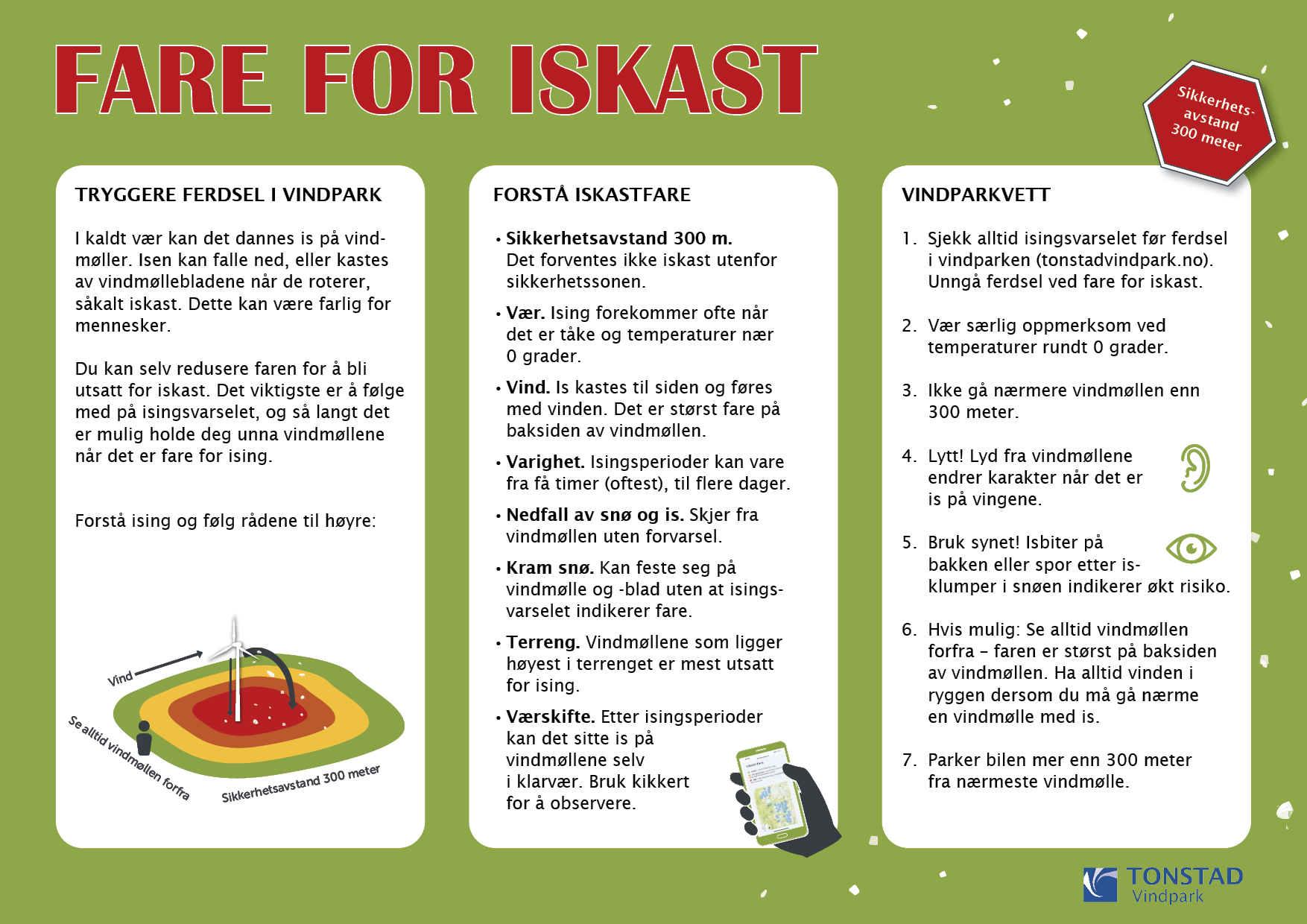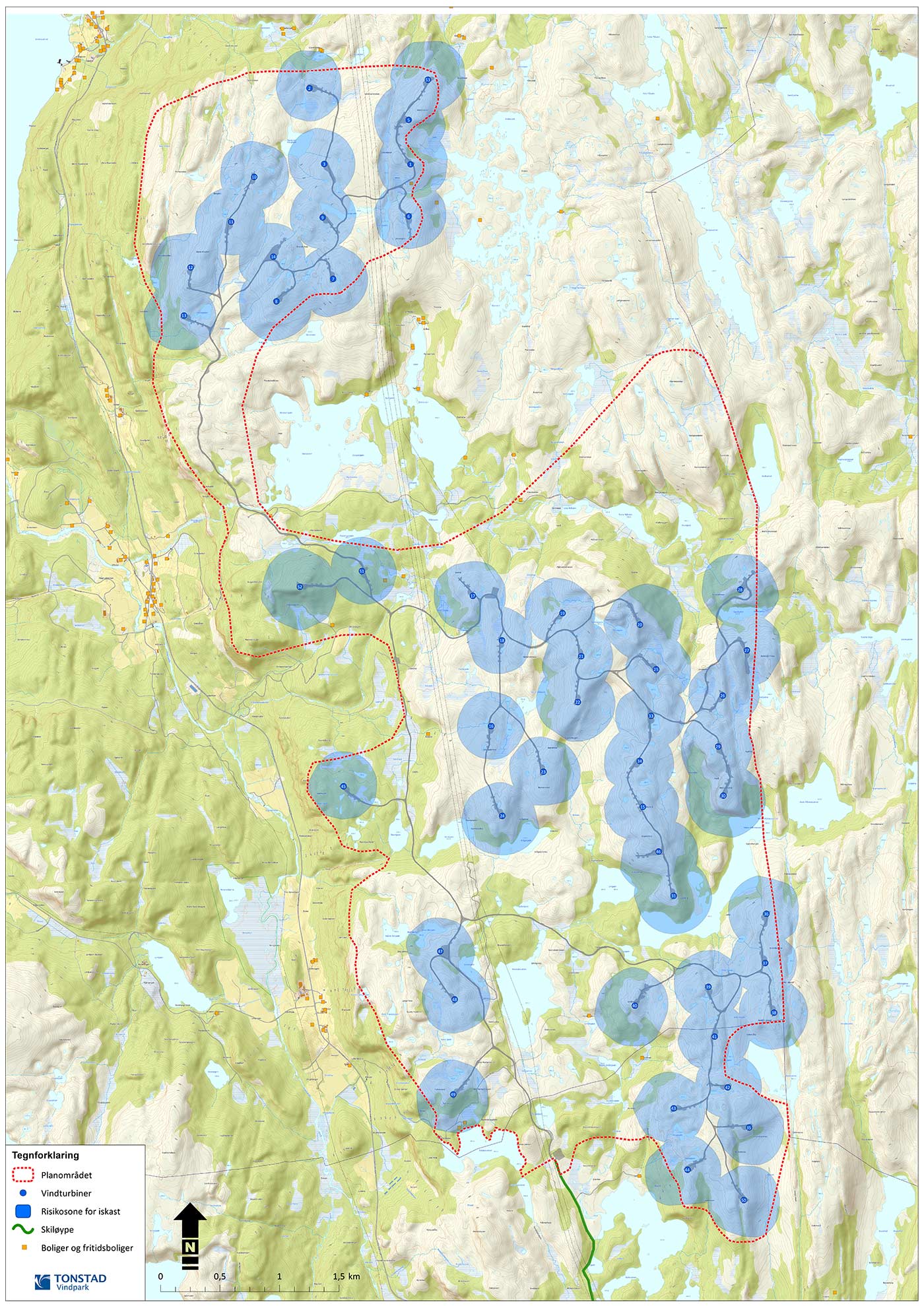Iskast-fare:
I vinterhalvåret vil det være perioder hvor det dannes is eller ligger snø på vindturbinene. Da er det en risiko for at is/snø faller ned eller kastes av. Overhold sikkerhetssonen på 300meter som er oppgitt på skilt i vindkraftverket.
Det er flere værforhold som kan forårsake nedfall og kast av is og snø fra vindturbiner. Situasjoner som kan medføre fare for iskast eller is-/snøfall kan skyldes at is bygger seg opp på turbinbladene, at det legger seg våt snø på blad, tårn eller turbinhuset eller at det dannes istapper på grunn av underkjølt regn på turbinen. I vinterhalvåret er det alltid en risiko for fallende is/snø fra turbinhuset og vi anbefaler derfor å unngå ferdsel i umiddelbar nærhet til turbinene.
Faktorer som kan påvirke risikoen for å utsettes for iskast/isnedfall:
- Faren øker med nærhet til turbinene.
- Vær spesielt oppmerksom ved oppstart av turbiner etter at de har stått i ro.
- Sjekk værvarselet. Det er størst risiko for ising ved lavt skydekke, når det er eller nettopp har vært tåke eller nedbør og ved temperaturer rundt 0 grader.
- Se om du kan se is eller snø på bladene eller andre deler av turbinen. Det kan også ligge is på selve tårnet eller henge istapper fra toppen av tårnet.
- Opphold deg aldri rett under turbinen.
- Is og snø vil drive med vinden og skal du gå nær en turbin bør du gå med vinden i ryggen.
Under vises en prognose over risiko for ising i Tonstad Vindpark. Varselet er basert på metorologiske data samt scadadata fra turbinene og oppdateres automatisk 4 ganger i døgnet. Varselet kan ikke brukes som en entydig indikator på at det ikke er ising da det er basert på meteorologiske prognoser. Varselet er ment som et tillegg til skiltinformasjon for å kunne vurdere egen risiko. Varselet for Tonstad Vindpark angir sannsynligheten for at det er is på turbinene.

Hva er iskast?
Atmosfærisk ising oppstår når vanndråper i luften fryser til is på gjenstander de kommer i kontakt med.
Den vanligste formen for atmosfærisk ising inntreffer når underkjølte skydråper fryser til is på konstruksjoner (skyising), men ising kan også forekomme i nedbørsepisoder med underkjølt regn eller våt snø.
I perioder med slike klimatiske forhold kan det oppstå is på vindturbinens tårn, maskinhus (nacelle) og rotorblader.
De klimatiske forholdene kan variere mye innenfor et lite geografisk område. Dette gjør at det kan være store forskjeller i omfanget av ising mellom de ulike vindturbinene i et vindkraftverk.
NB: På grunn av høydeforskjellen mellom vindturbinen og bakken, kan det dannes is på vindturbinen selv om det er snø- og isfritt på bakken.
Den 3 år lange måleserien som er tilgjengelig fra området viste at ising har forekommet på instrumentene 7.1 % av året, som svarer til ca. 25 dager.
Is som faller ned og kastes fra en vindturbin omtales som iskast.
Iskast kan utgjøre en fare for folk eller dyr som ferdes i nærheten av turbinene. Is som faller av et turbinblad kan også medføre mindre skader på selve turbinen.
Det er i beregninger antatt at isbitene alltid kastes 90 grader til høyre for vindretningen, med et lite tillegg på 15 grader i vindens retning. Med vind hovedsakelig fra østlig retning under isingsforhold er det i beregningene antatt en stor sannsynlighet for iskast mot nord-nordvest og nord. I realiteten vil det være en relativt stor spredning i kastretningene og bruk av retningsfordelingen kan derfor være noe misvisende.
Sannsynligheten for at en person blir truffet er veldig liten, men om det skjer kan skadeomfanget bli alvorlig.
Sjekk derfor alltid isingsprognosen på hjemmesiden vår før du går inn i vindparken.
Takk for at du samarbeider med oss slik at ingen blir utsatt for unødvendig fare og kan komme til skade.
Ferdselsråd
- Sjekk isvarsling på nettsidene
- Faren øker med nærhet til turbinene
- Anbefalt sikkerhetsavstand er 300 meter
- Vurder værforholdene: Det er størst risiko ved tåke og temperatur rundt 0 grader.
- Skal du gå nær en vindturbin med is, gjør det med vinden i ryggen. Eventuelle isbiter vil drive medvinds.

Nyheter
Kontakt oss
Kontakt oss ved å ringe nummeret under eller send en beskjed gjennom kontaktskjema.
47704435
